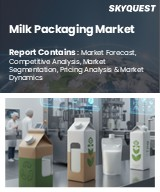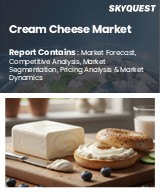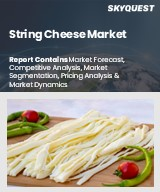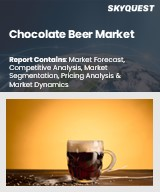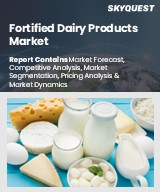
|
시장보고서
상품코드
1773348
유아용 우유 시장 기회, 성장 촉진요인, 산업 동향 분석, 예측(2025-2034년)Baby Milk Market Opportunity, Growth Drivers, Industry Trend Analysis, and Forecast 2025 - 2034 |
||||||
세계의 유아용 우유 시장은 2024년에 165억 달러로 평가되며, CAGR 5.4%로 성장하며, 2034년에는 277억 달러에 달할 것으로 추정되고 있습니다.
이 시장은 특히 모유 수유를 할 수 없거나 모유 수유를 선택하지 않는 어머니를 위한 영아 영양 지원에 도움이 됩니다. 이 카테고리에는 영아용 조제분유(6개월까지), 후속 조제분유(6-12개월), 성장기 조제분유(12-36개월), 유당불내증, 조산, 기타 민감한 건강상의 필요를 위해 개발된 특수 제품 등 다양한 제형이 포함됩니다. 이러한 분유 제품은 모유를 모방하도록 과학적으로 설계되어 탄수화물, 지방, 단백질, 비타민, 미네랄 등 건강한 성장에 필요한 필수 영양소를 공급합니다. 워킹맘 증가, 디지털 및 소매 플랫폼을 통한 제품 접근성 향상, 클린 라벨 및 유기농 대체품에 대한 관심 증가 등이 이 시장의 성장세를 견인하고 있습니다.
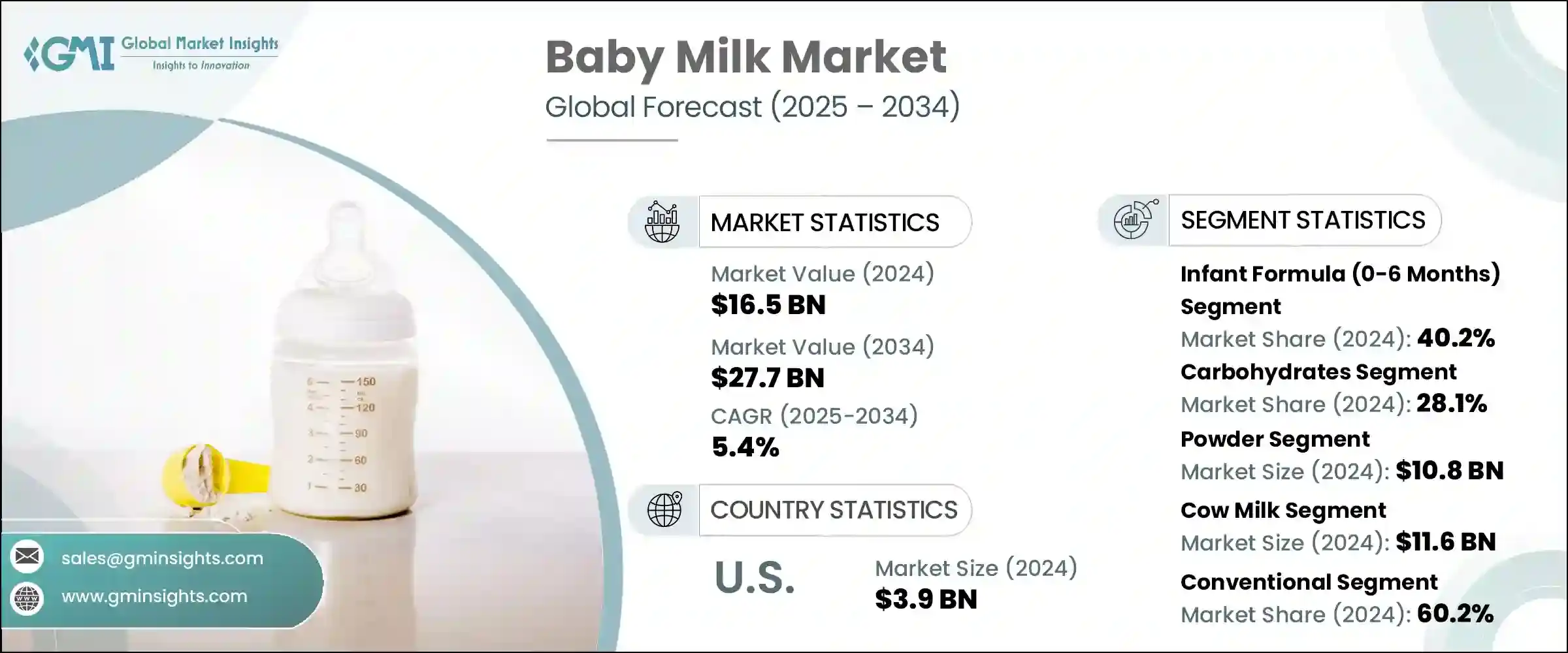
소비자 취향의 진화로 인해 분유 카테고리가 재편되고 있으며, 기업은 건강 지향적 육아에 부합하는 안전하고 효율적이며 영양이 풍부한 선택을 제공하도록 장려하고 있습니다. 오늘날의 부모들은 기본적인 영양뿐만 아니라 제품의 투명성, 클린 라벨, 유기농 조달, 인공첨가제 무첨가 등에도 점점 더 많은 관심을 기울이고 있습니다. 이러한 변화로 인해 제조업체들은 유전자 변형이 없는 원료, 장 건강을 위한 프로바이오틱스, 유당불내증, 알레르기, 조산 등 특정 요구 사항에 맞게 제품을 개선하고 있습니다. 이제 부모들은 더 많은 정보를 얻고 임상 연구와 의학적 권장사항이 지원되는 제품을 찾게 되었습니다.
| 시장 범위 | |
|---|---|
| 시작연도 | 2024 |
| 예측연도 | 2025-2034 |
| 시작 금액 | 165억 달러 |
| 예측 금액 | 277억 달러 |
| CAGR | 5.4% |
영아용 조제분유 부문은 2024년 40.2%의 점유율을 차지하며 2034년까지 연평균 5.6%의 성장률로 2034년까지 주도권을 유지할 것으로 예측됩니다. 영유아가 가장 취약하고 균형 잡힌 영양 공급이 필요한 생후 6 개월 동안 부모는 이 분야에 큰 신뢰를 가지고 있습니다. 이 포뮬러는 모유에 함유된 주요 영양소를 충실히 모방하여 완벽한 영양 공급을 위해 만들어졌습니다. 부모들의 건강에 대한 인식이 높아짐에 따라 특히 도시 가정에서는 고품질의 의학적으로 승인된 유아용 조제분유에 대한 수요가 이 카테고리의 강력한 원동력이 되고 있습니다.
탄수화물 부문은 2024년 28.1%의 점유율을 차지하며, 2034년까지 연평균 5.5%의 성장률을 보일 것으로 예측됩니다. 대부분의 유아용 조제분유에 함유된 주요 탄수화물인 유당은 중요한 에너지원으로 작용하며, 뇌 발달과 건강한 장내세균총과 같은 중요한 기능을 지원합니다. 또한 칼슘의 흡수를 높이고 골격 발달을 촉진하는 역할도 합니다. 단백질, 비타민, 지방, 프리바이오틱스와 같은 다른 성분들이 면역 방어, 대사 기능, 조직 복구에 필수적인 반면, 탄수화물은 유아의 성장에 기초적인 역할을 하므로 여전히 중심적인 역할을 합니다. 다른 영양소와의 시너지 효과로 인해 탄수화물은 제품 배합에서 계속 중요한 위치를 차지하고 있습니다.
미국 분유 시장 규모는 2024년 39억 달러로 2034년까지 연평균 4.4%의 성장률을 보일 것으로 예측됩니다. 미국은 성숙한 분유 제조 부문, 다양한 제품 접근성, 고도로 정보화된 소비자 기반 등의 이점을 누리고 있습니다. 진화하는 식생활 요구와 강력한 제품 공급 능력으로 인해 표준 분유와 특수 분유에 대한 수요는 지속적으로 높은 수준을 유지하고 있습니다. Abbott Laboratories, Nestle, Mead Johnson(Reckitt)과 같은 전통적 기업의 존재는 기술 혁신 주기와 공급망 강도에 지속적으로 영향을 미치고 있으며, 미국을 이 지역 분유 산업의 핵심으로 만들고 있습니다.
세계의 유아용 우유 시장을 형성하는 주요 기업에는 Abbott Laboratories, Arla Foods Amba, Bellamy's Organic, Biostime(H&H Group), Ausnutria Dairy Corporation Ltd. 등이 있습니다. 유아식 분야의 주요 기업은 제품 혁신, 규제 준수, 소비자 교육에 중점을 둔 전략을 통해 입지를 강화해 나가고 있습니다. 많은 기업이 연구개발에 투자하고, 프로바이오틱스, 유기농 성분, 알레르겐 프리 성분을 강화한 제형을 도입하고 있습니다. 또한 기업은 E-Commerce 플랫폼, 약국, 헬스케어 네트워크와의 제휴를 강화하여 유통 범위를 확대하기 위해 노력하고 있습니다. 포장 및 클린 라벨 인증과 관련된 지속가능성 노력은 특히 건강을 중시하는 부모들 사이에서 중요한 차별화 요소로 작용하고 있습니다.
목차
제1장 조사 방법
- 시장의 범위와 정의
- 조사 디자인
- 조사 어프로치
- 데이터 수집 방법
- 데이터 마이닝 소스
- 세계
- 지역/국
- 기본 추정과 계산
- 기준연도 계산
- 시장 예측의 주요 동향
- 1차 조사와 검증
- 1차 정보
- 예측 모델
- 조사의 전제와 한계
제2장 개요
제3장 업계 인사이트
- 에코시스템 분석
- 공급업체의 상황
- 이익률
- 각 단계에서의 부가가치
- 밸류체인에 영향을 미치는 요인
- 파괴적 변화
- 업계에 대한 영향요인
- 촉진요인
- 업계의 잠재적 리스크 & 과제
- 시장 기회
- 성장 가능성 분석
- 규제 상황
- 북미
- 유럽
- 아시아태평양
- 라틴아메리카
- 중동 및 아프리카
- Porter의 산업 분석
- PESTEL 분석
- 가격 동향
- 지역별
- 제품별
- 향후 시장 동향
- 테크놀러지와 혁신의 상황
- 현재 기술 동향
- 신규 기술
- 특허 상황
- 무역통계(HS 코드)(주 : 무역통계는 주요 국가만 제공)
- 주요 수입국
- 주요 수출국
- 지속가능성과 환경 측면
- 지속가능 관행
- 폐기물 삭감 전략
- 생산에서의 에너지 효율
- 친환경 구상
- 사회적 책임 구상
- 윤리적인 마케팅 관행
- 모자 보건 프로그램
- 커뮤니티 관여
- 노동 관행과 인권
- 거버넌스와 투명성
- 기업 거버넌스 구조
- 윤리적인 비즈니스 관행
- 공급망 투명성
- 이해관계자 관여
- 지속가능성 인증과 기준
- ESG 투자의 동향
- 지속가능 생산의 미래
- 신규 기술과 혁신
- 처방 구성에서의 혁신
- 모유 올리고당(HMOS)
- mfgm(Milk fat globule membrane)
- 프로바이오틱스와 프리바이오틱스
- 식물 유래 처방
- 제조 및 가공 혁신
- 첨단 건조 기술
- 무균 처리
- 품질관리의 혁신
- 생산과 공급망에서의 디지털 변혁
- 인더스트리 4.0 애플리케이션
- 이력추적을 위한 블록체인
- AI와 기계학습 애플리케이션
- 포장 혁신
- 지속가능 포장재료
- 스마트 패키징 기술
- 편리성을 중시한 패키지
- 처방 구성에서의 혁신
- 디지털 전환과 E-Commerce의 동향
- 시장 개요
- 옴니채널 전략과 실장
- 소비자 직판(D2C) 비즈니스 모델
- 서브스크립션 서비스와 자동 보충
- 디지털 마케팅 전략
- 소셜미디어 마케팅
- 인플루언서와의 파트너십
- 컨텐츠 마케팅
- 모바일 마케팅
- 디지털 플랫폼과 마켓플레이스의 분석
- 디지털 커머스의 미래 유아용 우유 시장
- 소비자 행동 분석
- 구입 결정 요인
- 브랜드 로열티와 환승 행동
- 가격 민감도 분석
- 채널 선호와 옴니채널 행동
- 구매 패턴에 대한 인구통계학적 영향
제4장 경쟁 구도
- 서론
- 기업의 시장 점유율 분석
- 지역별
- 북미
- 유럽
- 아시아태평양
- 라틴아메리카 항공
- 중동 및 아프리카
- 지역별
- 기업 매트릭스 분석
- 주요 시장 기업의 경쟁 분석
- 경쟁 포지셔닝 매트릭스
- 주요 발전
- 합병과 인수
- 파트너십과 협업
- 신제품 발매
- 확장 계획
제5장 시장 추산·예측 : 제품 유형별, 2021-2034
- 주요 경향
- 유아용 조제분유(0-6개월)
- Follow-on 우유(6-12개월)
- 성장기용 우유(12-36개월)
- 특수 유아용 분유
- 저알레르기성 처방
- 무유당
- 미숙아용 조제유
- 기타 특수 처방
제6장 시장 추산·예측 : 식재별, 2021-2034
- 주요 경향
- 탄수화물
- 지방
- 단백질
- 비타민과 미네랄
- 프리바이오틱스와 프로바이오틱스
- 기타
제7장 시장 추산·예측 : 형태별, 2021-2034
- 주요 경향
- 분말
- 액체 농축물
- Ready-to-feed
제8장 시장 추산·예측 : 소스별, 2021-2034
- 주요 경향
- 우유 기반
- 대두 기반
- 산양유 기반
- 기타 식물 유래 대체품
제9장 시장 추산·예측 : 자연별, 2021-2034
- 주요 경향
- 기존형
- 오가닉
- 비유전자변형
제10장 시장 추산·예측 : 유통 채널별, 2021-2034
- 주요 경향
- 하이퍼마켓과 슈퍼마켓
- 약국·드러그스토어
- 편의점
- 온라인 소매
- E-Commerce 플랫폼
- 소비자 직판 웹사이트
- 서브스크립션 서비스
- 전문점
- 기타
제11장 시장 추산·예측 : 지역별, 2021-2034
- 주요 동향
- 북미
- 미국
- 캐나다
- 유럽
- 독일
- 영국
- 프랑스
- 이탈리아
- 스페인
- 아시아태평양
- 중국
- 인도
- 일본
- 호주
- 한국
- 라틴아메리카
- 브라질
- 멕시코
- 아르헨티나
- 중동 및 아프리카
- 사우디아라비아
- 남아프리카공화국
- 아랍에미리트
제12장 기업 개요
- Arla Foods amba
- Ausnutria Dairy Corporation Ltd.
- Abbott Laboratories
- Bellamy's Organic
- Biostime(H&H Group)
- Bobbie
- Bubs Australia Limited
- ByHeart
- China Feihe Limited
- Danone S.A.
- FrieslandCampina N.V.
- Hipp GmbH &Co. Vertrieb KG
- Holle Baby Food AG
- Kendamil
- Mengniu Dairy
- Morinaga Milk Industry Co., Ltd.
- Nestle S.A.
- Perrigo Company plc
- Reckitt Benckiser Group plc(Mead Johnson)
- Yili Group
The Global Baby Milk Market was valued at USD 16.5 billion in 2024 and is estimated to grow at a CAGR of 5.4% to reach USD 27.7 billion by 2034. This market helps in supporting infant nutrition, especially for mothers who are unable or choose not to breastfeed. The category includes various formulations such as infant formula (for babies up to 6 months), follow-on formula (6 to 12 months), growing-up milk (12 to 36 months), and specialized products developed for lactose intolerance, premature birth, and other sensitive health needs. These milk products are scientifically engineered to simulate breast milk, delivering essential nutrients such as carbohydrates, fats, proteins, vitamins, and minerals necessary for healthy growth. The market's momentum is being fueled by higher rates of working mothers, improved access to products through digital and retail platforms, and growing interest in clean-label and organic alternatives.

Evolving consumer preferences are reshaping the baby milk category, pushing companies to deliver safe, efficient, and nutrient-rich options that align with health-conscious parenting. Today's caregivers are not only looking for basic nutrition but are increasingly concerned about product transparency, clean labels, organic sourcing, and the absence of artificial additives. This shift has led manufacturers to reformulate offerings with non-GMO ingredients, probiotics for gut health, and formulas tailored to specific needs such as lactose intolerance, allergies, or premature birth. Parents are now more informed and demand products backed by clinical research and medical endorsements.
| Market Scope | |
|---|---|
| Start Year | 2024 |
| Forecast Year | 2025-2034 |
| Start Value | $16.5 Billion |
| Forecast Value | $27.7 Billion |
| CAGR | 5.4% |
The infant formula segment held a 40.2% share in 2024 and is anticipated to maintain its leadership, growing at a CAGR of 5.6% through 2034. Parents rely heavily on this segment during the initial six months of life when infants are most vulnerable and need a carefully balanced nutritional solution. These formulas are crafted to deliver complete nourishment, closely mimicking the key nutrients found in breast milk. With health awareness rising among caregivers, demand for high-quality and medically approved infant formula remains a strong driver for the category, especially in urban households.
The carbohydrates segment held a 28.1% share in 2024 and is projected to rise at a 5.5% CAGR by 2034. Lactose, the primary carbohydrate in most baby milk formulas, serves as a critical energy source and supports vital functions such as brain development and healthy gut flora. It also plays a role in enhancing calcium absorption and promoting skeletal development. While other ingredients such as proteins, vitamins, fats, and prebiotics are essential for immune defense, metabolic function, and tissue repair, carbohydrates remain central due to their foundational contribution to infant growth. Their synergistic effect with other nutrients underscores their continued prominence in product formulations.
United States Baby Milk Market generated USD 3.9 billion in 2024 and is projected to grow at a 4.4% CAGR by 2034. The U.S. benefits from a mature formula manufacturing sector, wide-scale product accessibility, and a highly informed consumer base. Demand remains consistently high for both standard and specialized formulas, driven by evolving dietary needs and strong product availability. The presence of established players such as Abbott Laboratories, Nestle, and Mead Johnson (Reckitt) continues to influence innovation cycles and supply chain strength, making the U.S. a cornerstone of the baby milk industry in the region.
Key companies shaping the Global Baby Milk Market include Abbott Laboratories, Arla Foods Amba, Bellamy's Organic, Biostime (H&H Group), and Ausnutria Dairy Corporation Ltd. To reinforce their position, leading players in the baby milk sector are leveraging strategies that focus on product innovation, regulatory alignment, and consumer education. Many are investing in R&D to introduce formulations fortified with probiotics, organic ingredients, and allergen-free components. Companies are also working to expand their distribution reach by strengthening partnerships with e-commerce platforms, pharmacies, and healthcare networks. Sustainability initiatives around packaging and clean-label certifications have become key differentiators, especially among health-conscious parents.
Table of Contents
Chapter 1 Methodology
- 1.1 Market scope and definition
- 1.2 Research design
- 1.2.1 Research approach
- 1.2.2 Data collection methods
- 1.3 Data mining sources
- 1.3.1 Global
- 1.3.2 Regional/Country
- 1.4 Base estimates and calculations
- 1.4.1 Base year calculation
- 1.4.2 Key trends for market estimation
- 1.5 Primary research and validation
- 1.5.1 Primary sources
- 1.6 Forecast model
- 1.7 Research assumptions and limitations
Chapter 2 Executive Summary
- 2.1 Industry 360° synopsis
- 2.2 Key market trends
- 2.2.1 Regional
- 2.2.2 Product type
- 2.2.3 Ingredients type
- 2.2.4 Form
- 2.2.5 Source
- 2.2.6 Nature
- 2.2.7 Distribution channel
- 2.3 TAM Analysis, 2025-2034
- 2.4 CXO perspectives: Strategic imperatives
- 2.4.1 Executive decision points
- 2.4.2 Critical success factors
- 2.5 Future Outlook and strategic recommendations
Chapter 3 Industry Insights
- 3.1 Industry ecosystem analysis
- 3.1.1 Supplier Landscape
- 3.1.2 Profit Margin
- 3.1.3 Value addition at each stage
- 3.1.4 Factor affecting the value chain
- 3.1.5 Disruptions
- 3.2 Industry impact forces
- 3.2.1 Growth drivers
- 3.2.2 Industry pitfalls and challenges
- 3.2.3 Market opportunities
- 3.3 Growth potential analysis
- 3.4 Regulatory landscape
- 3.4.1 North America
- 3.4.2 Europe
- 3.4.3 Asia Pacific
- 3.4.4 Latin America
- 3.4.5 Middle East & Africa
- 3.5 Porter's analysis
- 3.6 PESTEL analysis
- 3.6.1 Technology and innovation landscape
- 3.6.2 Current technological trends
- 3.6.3 Emerging technologies
- 3.7 Price trends
- 3.7.1 By region
- 3.7.2 By product
- 3.8 Future market trends
- 3.9 Technology and Innovation landscape
- 3.9.1 Current technological trends
- 3.9.2 Emerging technologies
- 3.10 Patent landscape
- 3.11 Trade statistics (HS code) (Note: the trade statistics will be provided for key countries only)
- 3.11.1 Major importing countries
- 3.11.2 Major exporting countries
- 3.12 Sustainability and environmental aspects
- 3.12.1 Sustainable practices
- 3.12.2 Waste reduction strategies
- 3.12.3 Energy efficiency in production
- 3.12.4 Eco-friendly initiatives
- 3.13 Social responsibility initiatives
- 3.13.1 Ethical marketing practices
- 3.13.2 Maternal & infant health programs
- 3.13.3 Community engagement
- 3.13.4 Labor practices & human rights
- 3.14 Governance & transparency
- 3.14.1 Corporate governance structures
- 3.14.2 Ethical business practices
- 3.14.3 Supply chain transparency
- 3.14.4 Stakeholder engagement
- 3.15 Sustainability certifications & standards
- 3.16 ESG investment trends
- 3.17 Future of sustainable baby milk production
- 3.18 Emerging technologies & innovations
- 3.18.1 Innovations in formula composition
- 3.18.1.1 Human milk oligosaccharides (hmos)
- 3.18.1.2 Milk fat globule membrane (mfgm)
- 3.18.1.3 Probiotics & prebiotics
- 3.18.1.4 Plant-based formulations
- 3.18.2 Manufacturing & processing innovations
- 3.18.2.1 Advanced drying technologies
- 3.18.2.2 Aseptic processing
- 3.18.2.3 Quality control innovations
- 3.18.3 Digital transformation in production & supply chain
- 3.18.3.1 Industry 4.0 applications
- 3.18.3.2 Blockchain for traceability
- 3.18.3.3 Ai & machine learning applications
- 3.18.4 Packaging innovations
- 3.18.4.1 Sustainable packaging materials
- 3.18.4.2 Smart packaging technologies
- 3.18.4.3 Convenience-focused packaging
- 3.18.1 Innovations in formula composition
- 3.19 Digital transformation & e-commerce trends
- 3.19.1 market overview
- 3.19.2 Omnichannel strategies & implementation
- 3.19.3 Direct-to-consumer (D2C) business models
- 3.19.4 Subscription services & auto-replenishment
- 3.19.5 Digital marketing strategies
- 3.19.5.1 Social media marketing
- 3.19.5.2 Influencer partnerships
- 3.19.5.3 Content marketing
- 3.19.5.4 Mobile marketing
- 3.19.6 Digital platforms & marketplaces analysis
- 3.19.7 Future of digital commerce in baby milk market
- 3.20 Consumer behavior analysis
- 3.20.1 Purchase decision factors
- 3.20.2 Brand loyalty & switching behavior
- 3.20.3 Price sensitivity analysis
- 3.20.4 Channel preferences & omnichannel behavior
- 3.20.5 Demographic influence on purchasing patterns
Chapter 4 Competitive Landscape, 2024
- 4.1 Introduction
- 4.2 Company market share analysis
- 4.2.1 By region
- 4.2.1.1 North America
- 4.2.1.2 Europe
- 4.2.1.3 Asia Pacific
- 4.2.1.4 LATAM
- 4.2.1.5 MEA
- 4.2.1 By region
- 4.3 Company matrix analysis
- 4.4 Competitive analysis of major market players
- 4.5 Competitive positioning matrix
- 4.6 Key developments
- 4.6.1 Mergers & acquisitions
- 4.6.2 Partnerships & collaborations
- 4.6.3 New product launches
- 4.6.4 Expansion plans
Chapter 5 Market Estimates & Forecast, By Product Type, 2021-2034 (USD Million) (Kilo Tons)
- 5.1 Key trend
- 5.2 Infant formula (0-6 months)
- 5.3 Follow-on formula (6-12 months)
- 5.4 Growing-up formula (12-36 months)
- 5.5 Specialty baby formula
- 5.5.1 Hypoallergenic formula
- 5.5.2 Lactose-free formula
- 5.5.3 Premature baby formula
- 5.5.4 Other specialty formulas
Chapter 6 Market Estimates & Forecast, By Ingredient Type, 2021-2034 (USD Million) (Kilo Tons)
- 6.1 Key trend
- 6.2 Carbohydrates
- 6.3 Fats
- 6.4 Proteins
- 6.5 Vitamins & minerals
- 6.6 Prebiotics & probiotics
- 6.7 Others
Chapter 7 Market Estimates & Forecast, By Form, 2021-2034 (USD Million) (Kilo Tons)
- 7.1 Key trend
- 7.2 Powder
- 7.3 Liquid concentrate
- 7.4 Ready-to-feed
Chapter 8 Market Estimates & Forecast, By Source, 2021-2034 (USD Million) (Kilo Tons)
- 8.1 Key trend
- 8.2 Cow milk based
- 8.3 Soy based
- 8.4 Goat milk based
- 8.5 Other plant-based alternatives
Chapter 9 Market Estimates & Forecast, By Nature, 2021-2034 (USD Million) (Kilo Tons)
- 9.1 Key trend
- 9.2 Conventional
- 9.3 Organic
- 9.4 Non-GMO
Chapter 10 Market Estimates & Forecast, By Distribution Channel, 2021-2034 (USD Million) (Kilo Tons)
- 10.1 Key trend
- 10.2 Hypermarkets & supermarkets
- 10.3 Pharmacies & drug stores
- 10.4 Convenience stores
- 10.5 Online retail
- 10.5.1 E-commerce platforms
- 10.5.2 Direct-to-consumer websites
- 10.5.3 Subscription services
- 10.6 Specialty stores
- 10.7 Others
Chapter 11 Market Estimates & Forecast, By Region, 2021-2034 (USD Million) (Kilo Tons)
- 11.1 Key trends
- 11.2 North America
- 11.2.1 U.S.
- 11.2.2 Canada
- 11.3 Europe
- 11.3.1 Germany
- 11.3.2 UK
- 11.3.3 France
- 11.3.4 Italy
- 11.3.5 Spain
- 11.4 Asia Pacific
- 11.4.1 China
- 11.4.2 India
- 11.4.3 Japan
- 11.4.4 Australia
- 11.4.5 South Korea
- 11.5 Latin America
- 11.5.1 Brazil
- 11.5.2 Mexico
- 11.5.3 Argentina
- 11.6 Middle East & Africa
- 11.6.1 Saudi Arabia
- 11.6.2 South Africa
- 11.6.3 UAE
Chapter 12 Company Profiles
- 12.1 Arla Foods amba
- 12.2 Ausnutria Dairy Corporation Ltd.
- 12.3 Abbott Laboratories
- 12.4 Bellamy's Organic
- 12.5 Biostime (H&H Group)
- 12.6 Bobbie
- 12.7 Bubs Australia Limited
- 12.8 ByHeart
- 12.9 China Feihe Limited
- 12.10 Danone S.A.
- 12.11 FrieslandCampina N.V.
- 12.12 Hipp GmbH & Co. Vertrieb KG
- 12.13 Holle Baby Food AG
- 12.14 Kendamil
- 12.15 Mengniu Dairy
- 12.16 Morinaga Milk Industry Co., Ltd.
- 12.17 Nestle S.A.
- 12.18 Perrigo Company plc
- 12.19 Reckitt Benckiser Group plc (Mead Johnson)
- 12.20 Yili Group







